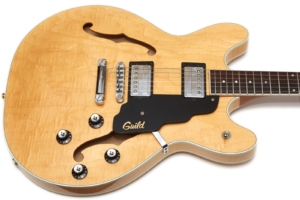
While this guitar is very similar to the 2000 Starfire IV mentioned above, it is also different in some ways that may not be obvious at first glance. Is it good enough to replace one of my favorite Guilds? Let’s find out.
Introduction
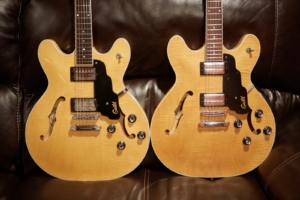
The Starfire IV has gone through some changes over the years and I won’t get into all of them here. Of course I would be remiss if I didn’t tell you to go buy Hans Moust’s book on the subject of Guild guitars which is where I got the introductory dates shown above. You can get Hans’ book through Amazon here, though at the time of this writing it looks to be out of print again.
Most guitarists I’ve met consider the Starfire IV to be a copy of the Gibson ES-335 because they’re superficially similar (double cutaway semi-hollow guitars), but having played both I personally prefer the Starfire. One of the things I dislike about the Gibson is the fact that the output jack is on the top whereas the jack on a Starfire is on the side and if you read my review of the 1981 S300, you’ll know that I have an irrational dislike of right-angle guitar cords.
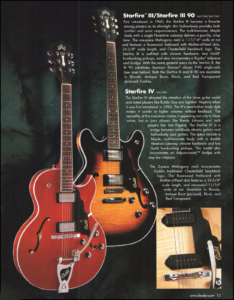
In the ’60s the Starfire IV had mini-humbuckers that many people go crazy for because of their amazing chime and tone. In the ’70s Guild moved to the larger HB-1 pickups which became the staple for this guitar until the early ’80s when the Starfire IV sported Guild XR-7 pickups made by Dimarzio. The fretboards on Starfire IVs were rosewood with dot inlays until the ’70s when they upgraded the inlays to blocks and added a master volume. In the ’80s the Starfire IV got an ebony fretboard and saw the return of the dot inlays. In the ’90s the HB-1s came back for a very limited time after which they were replaced by the SD-1 pickups as seen in this guitar. By 1997 the fretboard was back to rosewood which is also evident on this guitar.
I would be further remiss if I didn’t mention the fact that during the ’70s when the quality of damn-near everything in America was declining, Guild guitars maintained a high level of quality control which makes the Starfires from this era especially great. My only beef with Starfires from the 1970s is the fact that they tend to have really small necks. They sound absolutely killer, though, so if you like small necks on your semi-hollow guitars, find yourself a nice ’70s Starfire.
Finish
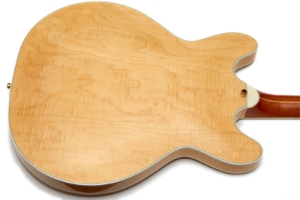
This blonde finish is my favorite for a Starfire IV because it really lets the nice flame shine through in just about any light though the flame does come and go with the angle of light, so it can be hard to capture the 3D effect given the fact that I insist on shooting from certain angles. Rest assured, though, that the Starfires of all models from this era usually have killer flame.
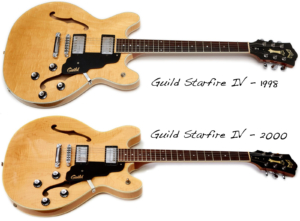
The perceived differences proved especially hard to photograph since I don’t have a real studio and don’t have the room or lighting to properly shoot them side by side. Normally I would bring them outside and shoot them in the grass but there was still snow on the ground here when I took these pictures so that wasn’t happening. As a result I ended up stitching two photos together which raises more questions than it answers since the colors look similar in the pics and thanks to slightly different angles, the bodies look different as well. Rest assured that aside from the difference in depth, the two guitars are identically shaped which i proved to myself by stacking them on top of one another (with a hidden soft cloth separating them, of course).
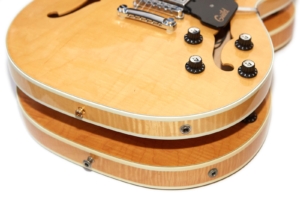
Fretboard and Neck
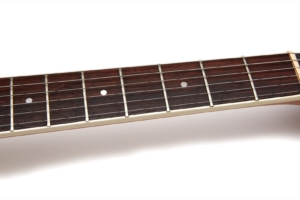
The frets measure a typical .08″ wide x about .02″ high (though frets can be a pain to measure) which roughly correlates to the medium jumbo fret size normally found on Guild electric guitars from the late 1990s. The fretboard is bound and there are no binding issues on this guitar.
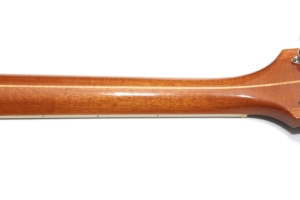
I measured the fretboard radius at 12″ which is fairly flat but not crazy-flat like some of those ’80s shred-machines. The neck is a three-piece mahogany affair which is kind of cool because the body of the guitar is maple. This is the same design as found on my 2000 Starfire IV and I really dig the combination of the bright maple body with the darker-sounding mahogany of the neck. As a result I think these guitars have a great balanced tone compared with some of the all-maple Starfires that I’ve owned.
Build Quality
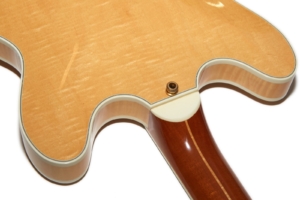
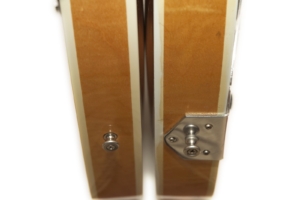
The 1998 Starfire that is the subject of this review is even thinner than the 2000 model, and I’d swear that the 1994 Starfire I stupidly sold was thinner still, though that may just be the perceptions of someone who is still annoyed that they let such a great guitar be sold. To summarize, here are three guitars measured by my over the years, two of which I still have in my possession:
Measured Starfire IV Differences
| Year | Depth(in) | Depth(cm) | Nut | Pickups | |
|---|---|---|---|---|---|
| 1973 | 1 7/8" | 4.76 cm | 1 5/8" | Guild HB-1 | |
| 1998 | 1 1/2" | 3.81 cm | 1 11/16" | SD SD-1 | |
| 2000 | 1 13/16" | 4.60 cm | 1 3/4-" | Fender HB-1 |
I’ve owned a few Starfire IVs from the ’70s and from what I can recall they all had very similar measurements with some having an extra millimeter or so of neck depth (not shown on the table) that made them more comfortable for my large hands.
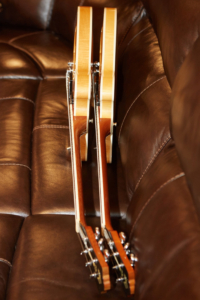
The output jack on the 1998 Starfire is about one inch (2.54 cm for those of you in countries with logical measuring systems) closer to the bottom strap peg than it is on the 2000 Starfire. This drove me nuts every time I went to plug it in because I’m so used to my 2000. Of course, this would not be a problem for a normal person who doesn’t have too many Guilds, but I found it interesting that the output jacks were not in the same location on the two guitars.
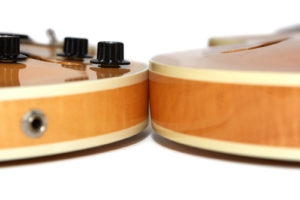
Pickups
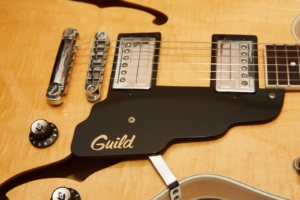
I really like the SD-1 pickups and I actually bought this guitar because of them, largely in part because I’m writing a long article where I compare all the different pickups covered in my verbosely named Guild Full-Sized HB1 and SD1 Pickup Variations article and needed a guitar with them for my late-night mad scientist experiments.
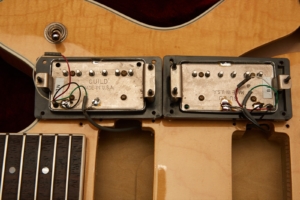
Measuring the pair in my 1998 Starfire IV, I get readings of 7.48k Ω (neck) and 8.0k Ω (bridge). This is a bit different than Guild HB-1s which usually measure about 7k Ω to 7.5k Ω territory. Of course, DC resistance is not the best way to measure pickups, but that’s a rant for another time. Suffice to say that while I really like the SD-1 pickups, they’re not quite HB-1s, though they are *way* better than the Fender-made HB-1s that would soon replace them.
Electronics
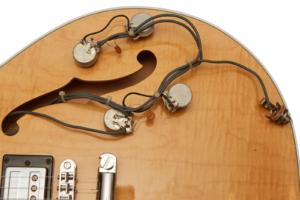
When I bought this guitar, the bridge volume pot was scratchy and would actually cut in and out when pressure was applied to the volume control. This guitar, though in excellent cosmetic condition, seems to have sat somewhere that allowed certain parts to corrode.
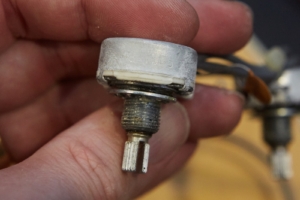
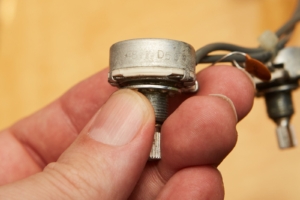
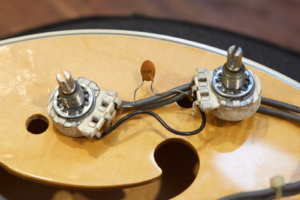
The capacitors are .02 μF ceramic disc capacitor which is the polar opposite of the gigantic bumblebee snake oil caps the $8000 Les Paul guys lust after. Aside from my snake-oil snub, I’ll leave the cap arguments for another time.
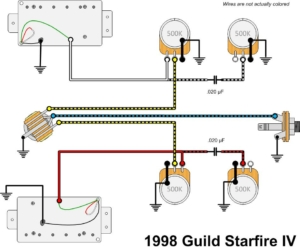
The pickups in this guitar are Seymour Duncan SD-1s and as such have four wires. The red/white wires are soldered together thus making the pickups functionally equivalent to two-wire models. The black wire is soldered to ground, as is the shielding from the wire used to connect the pickup to the volume pot. As with most Guild electrics from this era, the wiring is all grey which makes it a bit challenging to trace the wires when troubleshooting, but it’s a guitar not lunar lander, so it’s really not that big of a deal.
Hardware
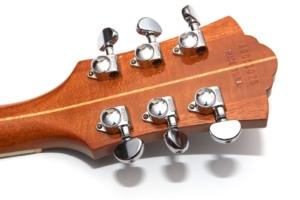
As mentioned, the bridge and the tailpiece are both made by Gotoh and work perfectly well. Though they don’t have the very Guildish panache of the ’70s Mueller-made bridge and cool harp tailpieces used back then, they work and they work well. I especially like that I can use a flat-head screwdriver to turn the adjustment screws because turning those knurled thumb rings gets old quick for this aging rock and roll rebel.
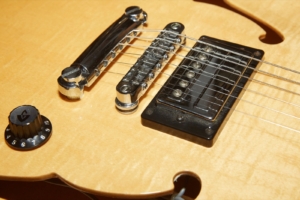
Sound
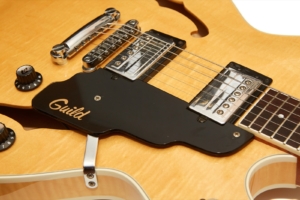
Of the three pickups settings, it’s hard to pick a favorite because they’re all so different. The neck pickup delivers a great jazzy tone without being too woofy, the middle position delivers a nice balanced tone while allowing for a bit of variety by rolling the volume and tone off of each pickup, and the bridge pickup just flat-out rocks.
Tiny Tweed
7th Chords
Open Chords #1
Open Chords #2
JCM-800
Barre Chords #1
Barre Chords #2
12th Fret Riff
BackLine
D-Shape Chords
For each recording I cycle through the neck pickup, both pickups, and finally the bridge pickup. All knobs on the guitar are on 10 at all times.
One of the things I kind of which this guitar had was the ability to split the pickups since the SD-1s are both 4-wire models. Having played a great number of Guilds that come with some cool tone options, I miss the ability to change the phase in the middle position, but that’s not really a deal breaker for me. I do think that a coil-split would be a nice addition to this guitar, though, and if I keep it I may just go that route by swapping out one of the tone pots for a push/pull.
A guitar like this is really about that semi-hollow sound, and it delivers that in every position and on every fret, though that sort of hollow timbre can obviously get lost when the gain is up high and the effects are set to overwhelming.
If you listen carefully to the 12th Fret Riff in the JCM-800 section you can hear a bit of a flubb on the first iteration. That’s me playing too aggressively and using my super-human vibrato technique to slide the low-E string right off the side of the fretboard. What can I say? I’m an animal when I get going. I also like to keep the clams in the recording so that you can see that they’re all real and all different between articles. Also I’m too lazy to re-record it.
Playability
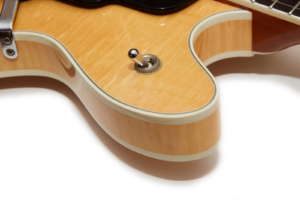
These later Starfires are a bit thinner than the vintage ’70s models which makes them a bit lighter and easier to manage. The roughly half inch between this and my fatter 2000 Starfire is even noticeable and while the deeper 2000 Starfire is by no means uncomfortable, the thinner 1998 is perhaps a tad more easy to play for long gigs. At times it almost seems too thin to me, though that’s probably because I’ve spent so much quality time with my beefier 2000 model. I will say that I flat-out prefer the SD-1 pickups over the original Fender HB-1s that came in my 2000, so if it comes down to tone above all else and your deciding between a 1998 and a 2000, I’d go for the 1998.

If you look at the picture to the right you can see that the pick guard sits on top of the pickup rings. To put it scientifically, that sucks. Why? Because it raises the pick guard into the area where my meaty hand is swinging the pick and I end up smacking the pick onto the pick guard all the time. No sir, I don’t like it.
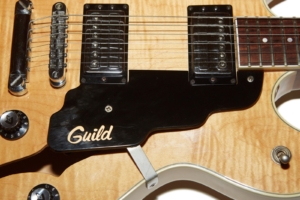
Seriously, this is something that Fender-owned Guild got right and I greatly prefer these later pick guards over the older ones to the point that if the 1998 model was my only Starfire I would seek out a 2000-style pick guard to use instead of the icky one that gets in my way all the time. Yes, I can just take it off, but I like the way they look even if it does have a goofy logo on it. Actually, as much as I’m generally against logos anywhere other than the headstock, the logo on these doesn’t bother me much when because it matches the color of the guitar.
Conclusion
When it comes to Starfires, I’m a fan, especially of the mighty Starfire IV. I like this guitar a lot and if not for the dumb pick guard, it would be close to perfect. Compared to my 2000 Starfire, this guitar has less flame and is missing the sort of aged look to the finish. It also has an icky pick guard. The necks on both of them are too close to call. Did I mention the pick guard? I’m pretty sure I did.
Where this 1998 Starfire IV wins hands-down over the 2000 model s the pickups. The Seymour Duncan SD-1 pickups in this guitar are much better than the Fender HB-1s which always sounded muddy and lifeless to me. While the SD-1s aren’t as delightful as the Guild HB-1s, they don’t disappoint in the tone department. Still, I’d categorize them as sounding a bit more modern than the wonderfully chimey HB-1s of yore and if you absolutely have to have HB-1s, the SD-1s are the same size so you can drop them right in. You can’t do that on a 2000 Starfire because the Fender pickups are smaller so the rings don’t work and you’d have to reroute the body of the guitar. Bummer.
This is an absolutely great guitar to own and I recommend it whole-heartedly. The pick guard may not bother you and if it does you can just take it off. The tone is great, the playability is great, it’s an absolute knockout in the looks department while delivering the goods with stylish aplomb in every way that a semi-hollow should.
To the great surprise of absolutely no one, I love this Guild.
Donate: PayPal Crypto:
ETH: 0x0AC57f8e0A49dc06Ed4f7926d169342ec4FCd461
Doge: DFWpLqMr6QF67t4wRzvTtNd8UDwjGTQBGs


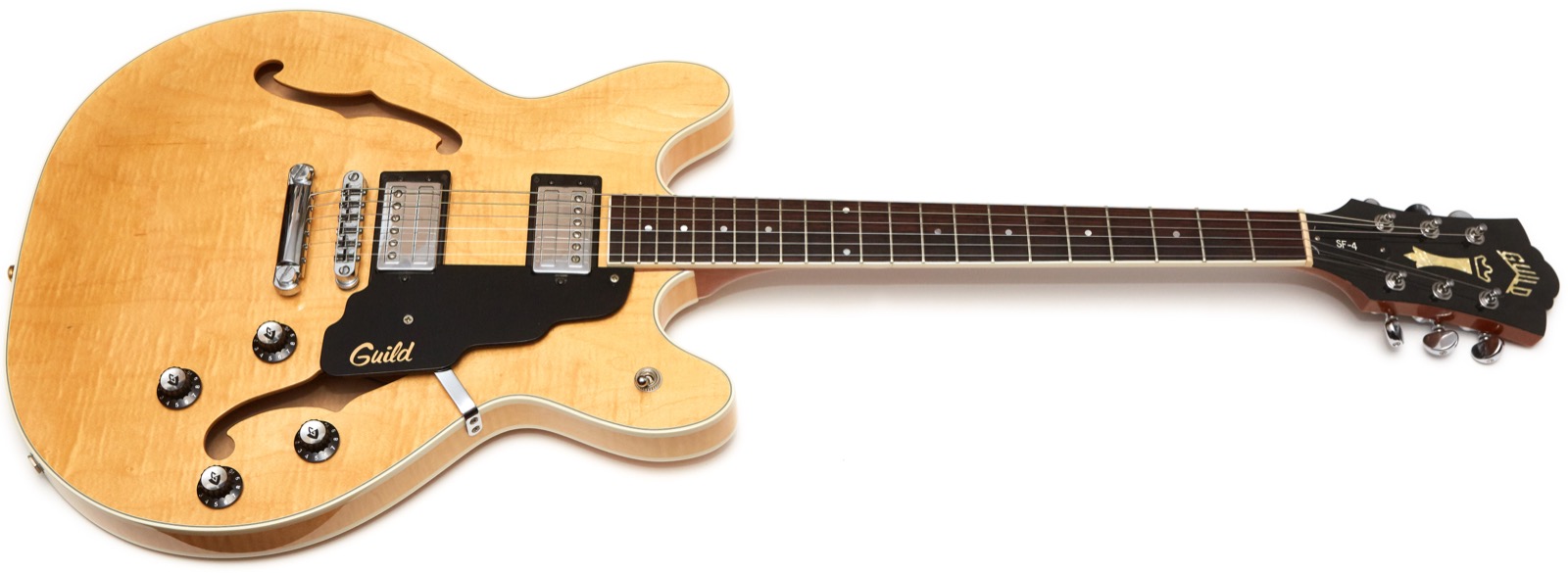
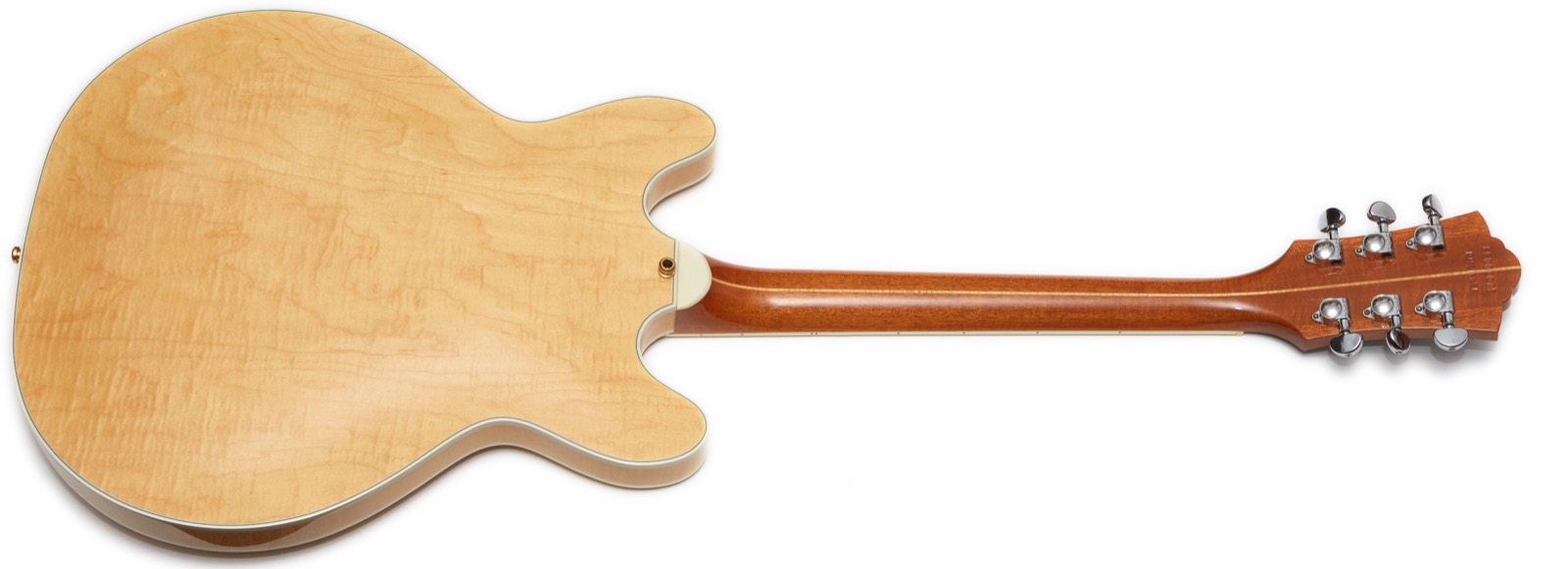
Hi, i really enjoyed reading this very informative. I’ve the opportunity to buy a 1990’s what est of cost would you place on a mint cherry version?
That really depends on when in the ’90s it’s from. Writing this in 2017, if it’s from 1997-1998 it will have the SD1 pickups and is more desirable; I’d pay up to $1200 USD. If it’s from 1994 it may have real Guild HB1s and it’s worth more – maybe $1500. If it’s from 1999 it may have Fender HB1s and is worth a little less: I’d say $1100. None of these are set in stone, though. If it’s *exactly* the guitar you want then it may be worth more to you. Good luck!
Cool summary. I have a 97 SF-4, but I took out the SD-1 and replaced them with a set of HB-1 from a 73 S-90. I don’t regret the switch at all. For sure the HB-1 neck pickup sounds better in the SF-4 than the SD-1 did. The bridge pickups were almost a dead heat, but the SD-1 neck pickup pales in comparison to an original HB-1. I am now thinking about putting the SD-1 into a late ’70s S-300D. The DiMarzio PAF/Super Distortion combo might be great if you want to sound like mid ’70s Ace Frehley, but it becomes a proverbial one trick pony rapidly. Maybe the SD-1 sound better for a solid body as I thought they sounded too woolly in the SF-4. I remember playing a 97 S100 reissue that I thought sounded exceptional. It most likely had the SD-1.
The SF-4 I have is different from almost all of the others I have seen from the late ’90s. Mine has a highly figured maple top with a quilted maple neck. Most all of the 97-99 SF-4 are like your guitar with a mahogany neck. As a result of the maple neck, it seems to have a slightly quicker response and for sure feels stiffer. My SF-4 didn’t come with a pickguard and I now totally get why it didn’t. I won’t bother looking for another as that is a stupid design for a pickguard. I also hadn’t really thought about the thickness of the body until I read this review. Mine is exactly like yours as it is definitively thinner than almost every SF-4 I have played. Mine is an excellent guitar. It hasn’t quite replaced the aforementioned S90 as my main Guild.
Hello,
Absolutely great review and very complete! About the 1997-1998 models, is there any chance that on some of this models, the pick guard doesn’t go on top of the pickup rings? or ALL of the models made in 97-98 have this pickguard ubication. So if a model presumed to be 1998, doesn’t have the pick guard on top of the rings its not really a 1998? what other years in the 1990’s would have the pickguard “around” the pickup rings?
Hey there – thanks for the comment! Your pick guard question is too detailed for my knowledge since my observations are based on what I’ve seen. Also, it’s possible that someone changed the pick guard on yours if you’re not the original owner or that the date is incorrect.
If you want to know the exact date of manufacture for your Guild, contact Hans Moust at https://www.guitarchives.nl/guitarsgalore/. He literally wrote the book about Guild guitars and has the original ledgers from Guild. He can tell you exactly when it was made (many of the online resources for Guild serial numbers are wrong).
HTH!
GAD
Thank you for these articles. Helped me tremendously in my search for my next baby. Appreciate all the info, especially the details of the neck and pickups. Just bought a 97 blond sf-4. Super stoked!
Thanks again!
Hi Gary
I am in possession of a guild JetStar bass guitar 1973 maybe which was my late fathers. It is not In the best of shape meaning it is missing most of its hardware. I would love to send you a picture of it in hope that you might be able to point me in the right path of possibly restoring it
Your best bet is to contact Hans Moust at https://www.guitarchives.nl/guitarsgalore/
He has an amazing archive of old Guild hardware. Good luck!
Hello.
First of all , thank you for this great review.
I have a chance to buy a 1997 Starfire 4. The condition is great and it sounds amazing, but I am bit uncertain about the frets. I messure a hight of 1mm ( .04“) They seem a bit low. The owner says they are original and not leveled.
You say the hight is about 0,02″ . that is 0,5mm. That is rather low. Could you please double check with your fret profile hight. And do you know the frets they used at that time?
Many thanks and greetings from Germany
Dimitri
Guilds of this era have low frets. The ones from the ’70s are even lower! I do not have that guitar recorded in my fret height spreadsheet, but other guitars from that era have frets that measure .04″ high, so your measurement seems right to me. FWIW I have many Guilds with frets that measure .025-.03″ as well.
I have a mint 2002 “Last of the Westerly’s” Starfire 4 Blond. Very little play and an exceptional maple flame (I think that’s why I bought it. Would be interested in selling to the right buyer….
Great article, thanks. I’m new to hollow bodies so please forgive the naive question. I tried a beautiful 90s Starfire II with a view to buy, but something gave concern. Is it normal for the back of the body to not be perfectly flat? It seems to have contours whereby it’s thinner around the outer edges.
Yup. Arched on front and back!
Thank you for this article, incredibly informative. Any opinions on buying new Korean made vs. 90’s model made in USA? I’m looking at a ’96 on Reverb. And any idea what the ST means on the contemporary models?
I will take a 90s Westerly over a Korean Newark St. Every time no question.
ST means “Stop Tail” on the new ones.
Thank you for that comment. Big help. These 90’s models are still made in USA through and through? …wondering if Fender incorporated Korean parts or production after they purchased the company…
Thanks again,
Tom
The pots are WD500s which are probably not made in the US. Since the marketing material for them doesn’t list a specific brand like CTS or Alpha and also doesn’t tout “Made in the USA”, I have to assume that they’re not US parts. The bridge and tailpiece are both Gotoh which is Japanese. Guild had used Gotoh parts for years and used Mueller (German) parts before that going back deep into the ’70s. The wooden parts of the guitar are absolutely US made.
This and your post on the different pickups was a great help in my search for a 90s SF4. I just landed a 98 model in antique burst with a beautiful flame top and neck (pretty sure it’s maple given the flame). It has the guild branded SD1s, which sound spectacular.
But that damn pickguard! I’m constantly hitting it with the pick on B and E string upstrokes. Tap, tap, tap, tap… Any luck on finding a suitable replacement? I wonder how difficult it would be to modify the existing guard…
Thanks! And congrats on the Starfire!
Honestly, I just remove the pick-guards from Starfires from that era. I can still anchor my pinky to the top and since the top is arched I never hit it with my pick, anyway.